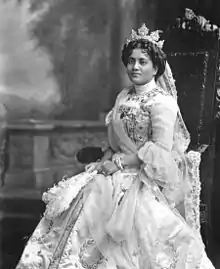Suniti Devi
Suniti Devi (or Sunity Devi) CIE (1864–1932) was the Maharani of Princely state of Coochbehar, India.[1]
Suniti Devi | |
|---|---|
 Her Highness, Maharani Suniti Devi, CIE of Cooch Behar State in the year 1902 at London | |
| Born | 30 September 1864 |
| Died | 10 November 1932 (aged 68) Ranchi |
| Nationality | Indian |
| Known for | Social worker, Educator |
Early life
She was a daughter of the renowned Brahmo Samaj reformist, Keshub Chandra Sen of Calcutta. She was married to Nripendra Narayan (1863-1911), the Maharaja of Cooch Behar in 1878, when she was only fourteen years of age. She stayed at her father's place for two years after marriage, as the Narayan left for London for higher studies immediately after their marriage.[2]
She was the mother of four sons and three daughters: sons Rajendra Narayan, Jitendra Narayan, Victor Nityendra Narayan, and Hitendra Narayan, and daughters Pratibha Devi, Sudhira Devi, and Sukriti Devi. [3][4]
Her daughters Sudhira and Pratibha married two brothers, Alan and Miles Mander, of Wightwick Manor in England. The Manor is part of the National Trust and open to visit. Of her sons, Rajendra Narayan and Jitendra Narayan later became Maharajas of Cooch Behar. Gayatri Devi and Ila Devi were daughters of her son Jitendra Narayan Bhup Bahadur.
Work
In 1887, her husband, Nipendra Narayan was awarded GCIE and she was awarded CIE. Suniti Devi became the first Indian women to be awarded CIE.[5] She attended the Diamond Jubilee celebrations of Queen Victoria in 1898 and Delhi Durbar of 1911 with her husband, the Maharaja of Cooch Behar. She along with her sister, the Sucharu Devi, were noted for their elegant style dressing.[6]
Her husband had set up in her name a girls school named Suniti College in 1881 which was later named Suniti Academy. Suniti Devi was the brain behind the establishment of the school.[4][7]
She was an educationist and a women's rights activist at heart, gave annual grants for the institution, exempted the girl students from paying tuition fees and also rewarded the successful students.[7] She had arranged for palace cars to ferry the girl students from home to school and back. In a further effort to avoid any controversy she ordered that the windows of the cars carrying the girls to school to be covered by curtains.[8]
She along with her sister Sucharu Devi also financed the foundation of Maharani Girls' High School at Darjeeling in 1908.[9] She was the President of State Council and also the first President of All Bengal Women's Union in 1932 and worked along with other women's right activist from Bengal like Charulata Mukherjee, Saroj Nalini Dutt, T. R Nelly and her sister Sucharu Devi, the Maharani of Mayurbhanj.[10]
She died suddenly in the year 1932 at Ranchi.
Titles
1887 - Companion of the Order of the Crown of India on the occasion of her attending with her husband Nripendra Narayan, the Golden jubilee celebration of Queen Victoria.[5]
Legacy
A road in her home town, Cooch Behar is named Sunity Road after her.
References
- "Sitter: H.H. Maharani Siniti Devi". Lafayette Negative Archive.
- Kaye, Joyoti Devi (1979). Sucharu Devi, Maharani of Mayurbhanj: a Biography. Writers Workshop. pp. 18, 24.
- Maharani Sunity Devi at geni.com
- Royal History: Book of Facts and Events, Ch. 5.
- North East India and her Neighbours. Indian Institute of Oriental Studies and Research. 1995. pp. 21, 24.
- Chaudhurani, Sarala Devi; Ray, Sukhendu (2010). The Many Worlds of Sarala Devi: A Diary. Berghahn Books. p. 76. ISBN 978-81-87358-31-2.
- Suniti Academy
- "Womens crusader for 125 years - Cooch behar school salutes Suniti devi on foundation day". The Telegraph. Calcutta, India. 8 February 2006. Retrieved 27 June 2012.
- Ramusack, Barbara N. (2004). The Indian Princes and Their States. 3. Cambridge University Press. p. 144. ISBN 978-0-521-26727-4.
- "Hidden behind a modest restaurant, decades of worth", indiatogether.com 31 August 2010
External links
| Wikimedia Commons has media related to Suniti Devi. |
- Works by Suniti Devi at Project Gutenberg
- Sunity Devee (1921), The Autobiography of an Indian Princess, London: J. Murray, on the Internet Archive